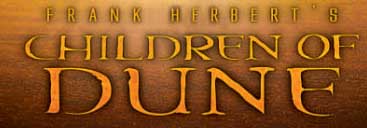

FRANK HERBERT’S CHILDREN OF DUNETHE WOMEN OF 'CHILDREN OF DUNE'Despite the saga's protagonist being male, it is definitely the women who fuel Children of Dune's dramatic tension. "The primary female characters are unusually powerful and strong in Frank Herbert's novels and not because they are like a 'Femme Nikita,' " explains Harrison. "In these stories the women are significant because they have political and intellectual clout and in some cases because they utilize their unique capacity for motherhood. Muad'Dib himself is at the center of a triangle of smart, empowered women (Irulan, Chani, and his mother, Lady Jessica). All have such incredible influence on him in terms of what he becomes. His mother was supposed to have a daughter who would change the world, and not the son she bore out of her love for Duke Leto, who wanted a boy. Lady Jessica defied the edict of her own Bene Gesserit sisterhood, which was to breed females who would have their special powers. Paul's the one who comes into being and changes history-and all the events in the Dune series are the direct result of his mother's choice. "Other female characters also play pivotal roles throughout Children of Dune in defining the drama and driving the plot," continues Harrison. "Look at Alia, a female character molded in the tradition of great tragic figures. This is a young woman who never had a chance, 'pre-born' in her mother's womb, she is sinking into madness, succumbing to ghostly possession when the evil Baron Harkonnen inhabits her soul." He adds, "I also feel no less tragic and fascinating is Princess Irulan, a woman in love with Muad'Dib, a man who will never love her in return. Ironically, it is she who is left to raise his children." Executive Producer Rubinstein always appreciated and respected the female friendly aspects of the books, which were not lost in the John Harrison scripts. "Frank Herbert populated his Dune worlds with empowered female characters more than 35 years ago, certainly long before it was fashionable." Rubinstein contends, "Herbert created female characters that women of almost any age can still relate to today. Characters that are universal in appeal irrespective of their appearing in a genre that is often regarded as not always providing depth in its female characters. The demographics of the audience for the first miniseries confirmed this perspective. The unusually large number of women that watched the first Dune mini for three nights straight was gratifying and commercially significant." With hindsight it appears Rubinstein has had an extremely successful track record in identifying and producing source material that based on genre would appear to skew much more male, but in fact appeals to women. Exit polls and ratings showed that more than 50% of the audiences were female for the Rubinstein produced miniseries adaptations of Stephen King's The Stand and The Langoliers, with the same being true of his feature production of Stephen King's Pet Sematary. "A good story is a good story. While one may traditionally think of science fiction as attracting fans of boy toys-ray guns, explosions, space ships - that's not what drives the audience to stay with the Dune stories, night after night. Children of Dune is just as much for anyone who doesn't ordinarily read or watch science fiction, as it is for the genre fans. The underlying foundation of the two miniseries and of Frank Herbert's books is interpersonal relationships. It's about families mixed in with action-adventure. Fathers and sons. Mothers and daughters. Grandparents and grandchildren. Ecology, Love, Sex, Loyalty, Betrayal. It is also about the Worms who call Arrakis home. Giant worms who are as dangerous and as sympathetic as the great movie monsters, like King Kong and Mighty Joe Young, were in their time." In fact, Rubinstein likes to describe the Children of Dune miniseries' multigenerational story as being in the tradition of Lawrence of Arabia, Gone With The Wind, Romeo and Juliet, All The King's Men, and Star Trek.
|
